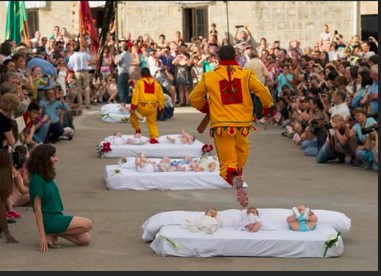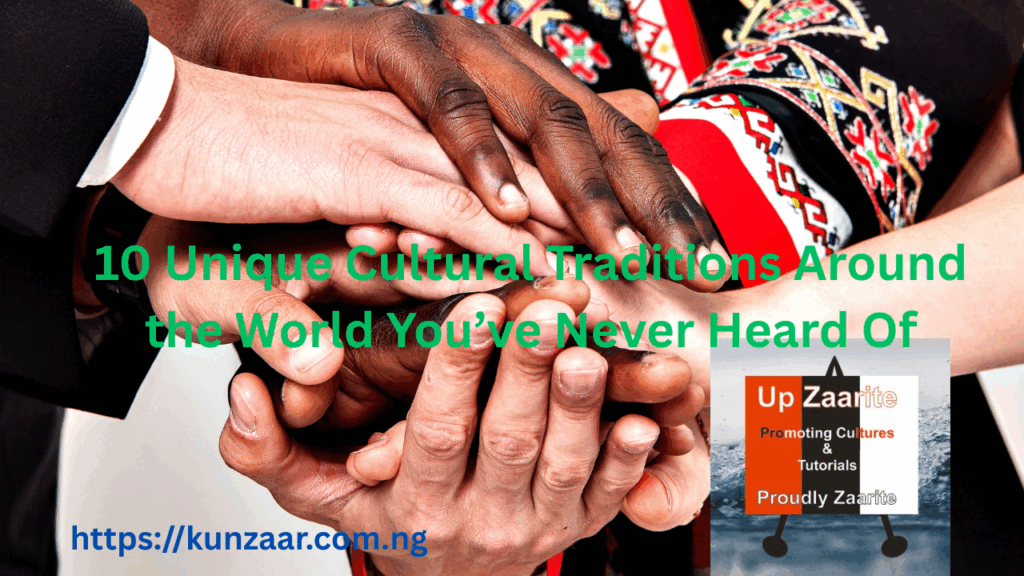Introduction
In a world with different customs and age-old practices, some cultural traditions remain hidden from the mainstream spotlight. While you may be familiar with Oktoberfest in Germany or Diwali in India, there are countless lesser-known yet fascinating cultural practices celebrated across the globe that are still existing while others have faded away.
In this post, we have 10 unique cultural traditions that you’ve probably never heard of—but definitely exist or has been in existence before it was banned or faded away due to modernization.
1. Baby Jumping Festival – Spain
Originally in Castrillo de Murcia, Spain and mostly celebrated in the month of June.
Baby Jumping Festival is thought to cleanse them of original sin and ward off evil spirits.

The infants, all born within the past year, are gently laid on mattresses in the street. Then, the “devils” run and jump over them in a dramatic display meant to ward off evil, cleanse original sin, and bless the children with goodness.
Also Read: The Sayawa (Zaar) Story During the Pre-Colonial Era
Known as El Colacho, this unusual festival has been celebrated since 1620. Men dressed as devils literally leap over newborn babies laid on mattresses in the street. The act is believed to cleanse the infants of original sin and offer protection from evil spirits. It’s a wild mix of Catholicism and folk tradition that you won’t see anywhere else.
2. Finger Cutting Ritual – Dani Tribe, Indonesia
In the Dani tribe of Papua, Indonesia, grief is shown through a profound and symbolic ritual. The women are the main objects in the finger cutting process.
Among the Dani people, grief for a lost loved one is expressed in a particularly intense way—by cutting off a segment of one’s finger. Though now banned, this ritual was once a common way for women to show mourning. It represents the pain of loss and the physical manifestation of grief.
3. Night of the Radishes – Mexico
Originated from Oaxaca, Mexico.
The Night of the Radishes or Noche de Rábanos in Spanish is an annual event held on December 23 and is a one-night-only festival that, as advertised, is centered around radishes which has been in existence for over 100 years ago in Mexico.
In this artistic tradition, giant radishes are carved into elaborate nativity scenes, mythical creatures, and historic depictions. This unique Christmas-season festival draws thousands of visitors and showcases the creativity and cultural pride of local artisans.
4. Wife Carrying Championship – Finland
The Wife carrying Championship was originated from Sonkajärvi, Finland and celebrated in the month of July every year.
The Wife Carrying World Championships have been held annually in Sonkajärvi, Finland, since 1992. This isn’t just a sport; it’s a celebration of partnership and resilience. It has inspired many couples to step out of their comfort zones and show their strength.
This lighthearted yet competitive tradition involves men racing through an obstacle course while carrying their wives (or partners) on their backs. The prize for the winner? The wife’s weight in beer! It’s bizarre, fun, and uniquely Finnish.
5. Kanamara Matsuri – Japan
Held annually in the month of April at the Kanayama shrine in Kawasaki, Japan the event is centered around the male and female reproductive organs. The festival focuses on themes of fertility and sexual health, and it features symbolic representations of male and female genitalia.
Also known as the Festival of the Steel Phallus, this is what this Shinto celebration centers around. The festival is both a fertility celebration and a fundraiser for HIV research. Expect bold parades, themed candies, and lots of laughter.
6. Living with the Dead – Madagascar
This festival is celebrated in the Highlands of Madagascar.
In some part of the world, seeing the remains of dead relatives would be akin to a nightmare or scary for most people. But for the Malagasy, it’s a reason to celebrate.
Famadihana or “Turning of the Bones,” is a tradition that existed four centuries ago and is still practiced till today to pay honors to the dead. This ritual involves exhuming ancestors, wrapping them in fresh cloth, and celebrating with music and dance. It’s a joyous reunion with the deceased and reinforces the Malagasy belief that death is just another phase of life. The festival for the dead held every five to seven years.
7. Monkey Buffet Festival – Thailand
Celebrated in Lopburi, Thailand in the month of November.
In Thailand, the Lopburi Monkey Banquet is one of the biggest and strangest festivals that celebrates the diversity of Thai cultures and the mischievous macaques who are said to be the descendants of God Hanuman. Hanuman, who is the greatest devotee of Lord Rama, played a major role in Ramayan.
In this one-of-a-kind event, locals prepare a massive buffet of fruits and treats for the city’s thousands of macaques. The monkeys are seen as bringers of good luck, and this festival both honors them and draws curious tourists from around the globe.
8. La Pourcailhade – France
This August festival that is celebrated in Trie-sur-Baïse, France.
La Pourcailhade or Pig-Squealing Festival is a silly festival in France. Contestants compete to produce the most realistic pig squeals, showcasing humor and creativity. This now-discontinued event saw participants mimicking pig sounds in various categories: feeding, mating, or being scared. The festival also features cooking competitions, parades, and other activities that highlight French rural culture. It was a hilarious tribute to the region’s agricultural roots and sense of humor.
9. Tinku Festival – Bolivia
The people of Macha, Bolivia celebrated this festival in every May.
Tinku is a thousand-year-old ceremony that is held in Bolivia. Men and women will meet and begin the festivities by dancing. What begins as a ritualistic street brawl ends in community bonding. Men and women of the Andes engage in organized fights, offering their blood to Pachamama (Mother Earth) to ensure a good harvest. While violent, the fights are rooted in a spiritual tradition of reciprocity.
10. Polterabend – Germany
This festival that is celebrated Across Germany is done Before a wedding.
There’s a tradition in Germany called polterabend. This is a German tradition that means “eve of making a racket” where guests are invited to gather the night before the wedding and smash porcelain. This pre-wedding tradition involves guests smashing porcelain (never glass!) in front of the bride and groom, who must then clean it up together. It symbolizes the idea that life, like marriage, involves cleaning up messes—together.

You Can Also Read: History and Origin of Swahili Language
These rare and intriguing cultural practices remind us of the incredible variety of human expression around the world. They may seem strange or even shocking to others that are outsiders, but to the communities that uphold them, they carry deep meaning, history, and identity to them. As global citizens, learning about these traditions helps us appreciate the rich tapestry of world cultures—beyond the mainstream.
Have You Witnessed a Unique Cultural Tradition?
Share your experience or suggest other rare traditions in the comments below! Don’t forget to add more cultural inside from around the world.

